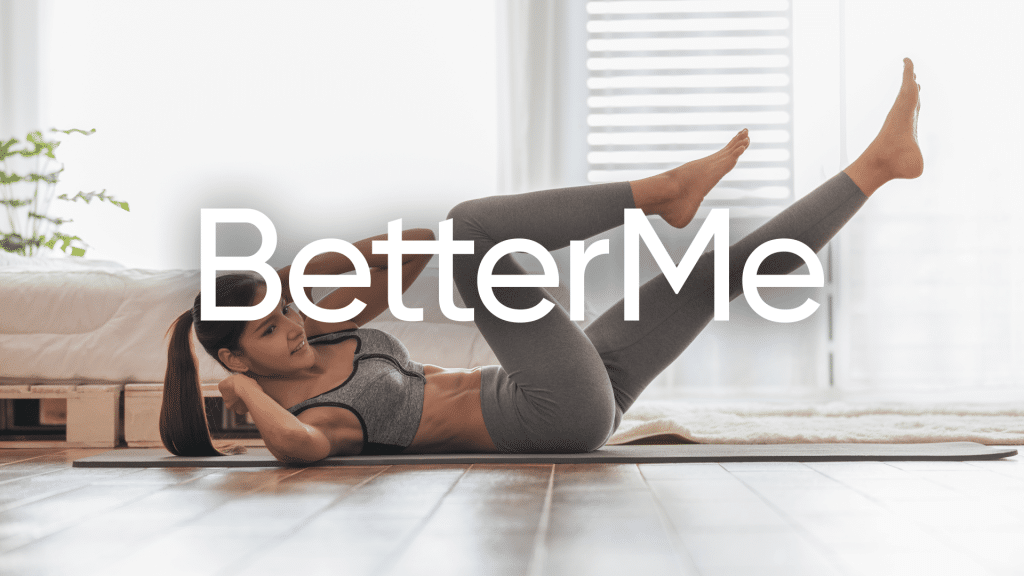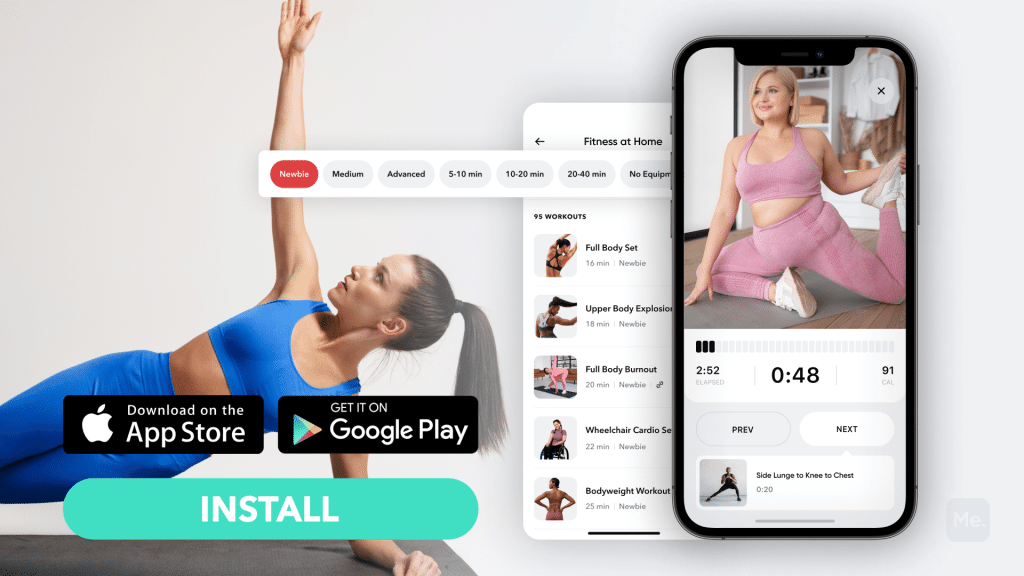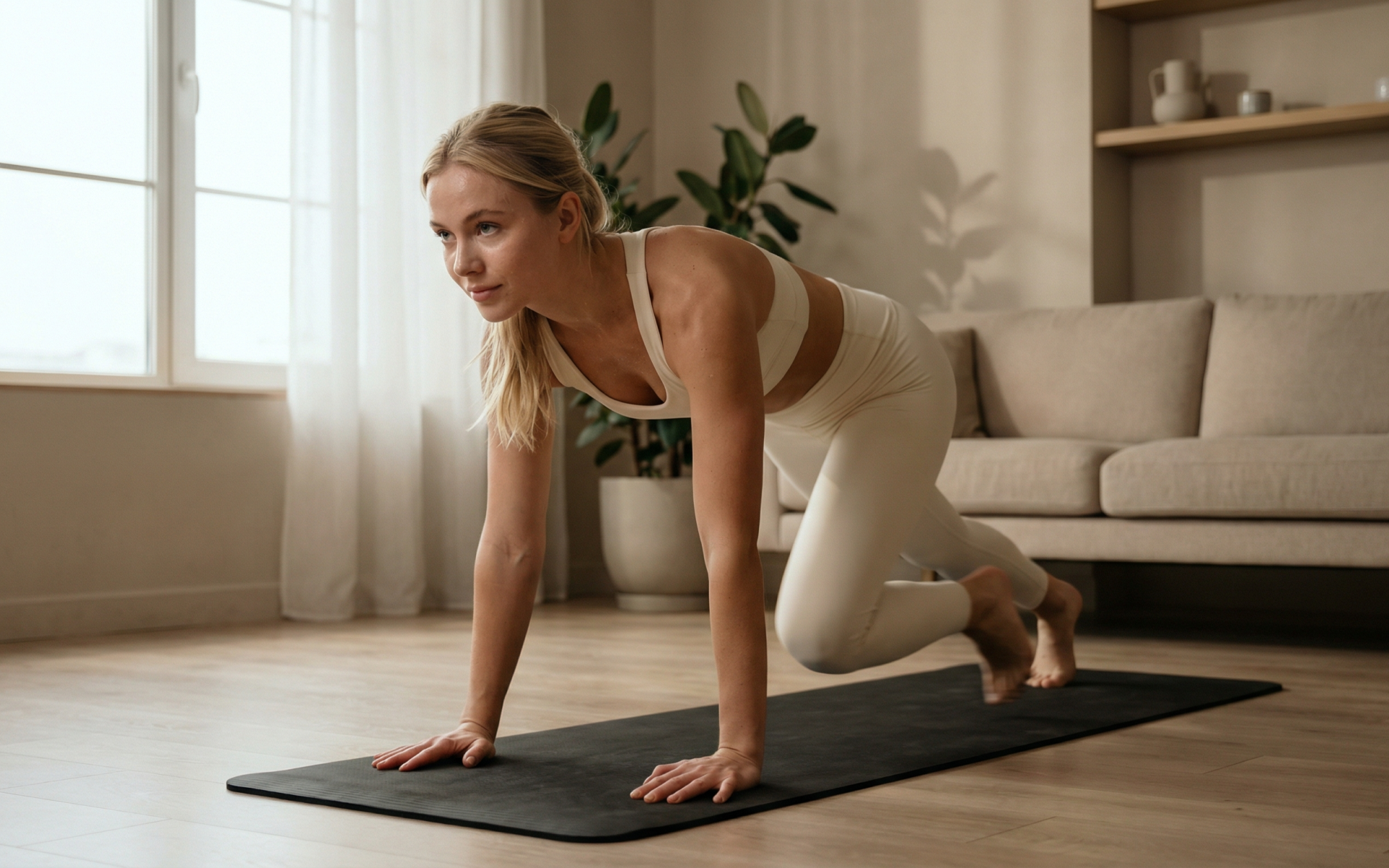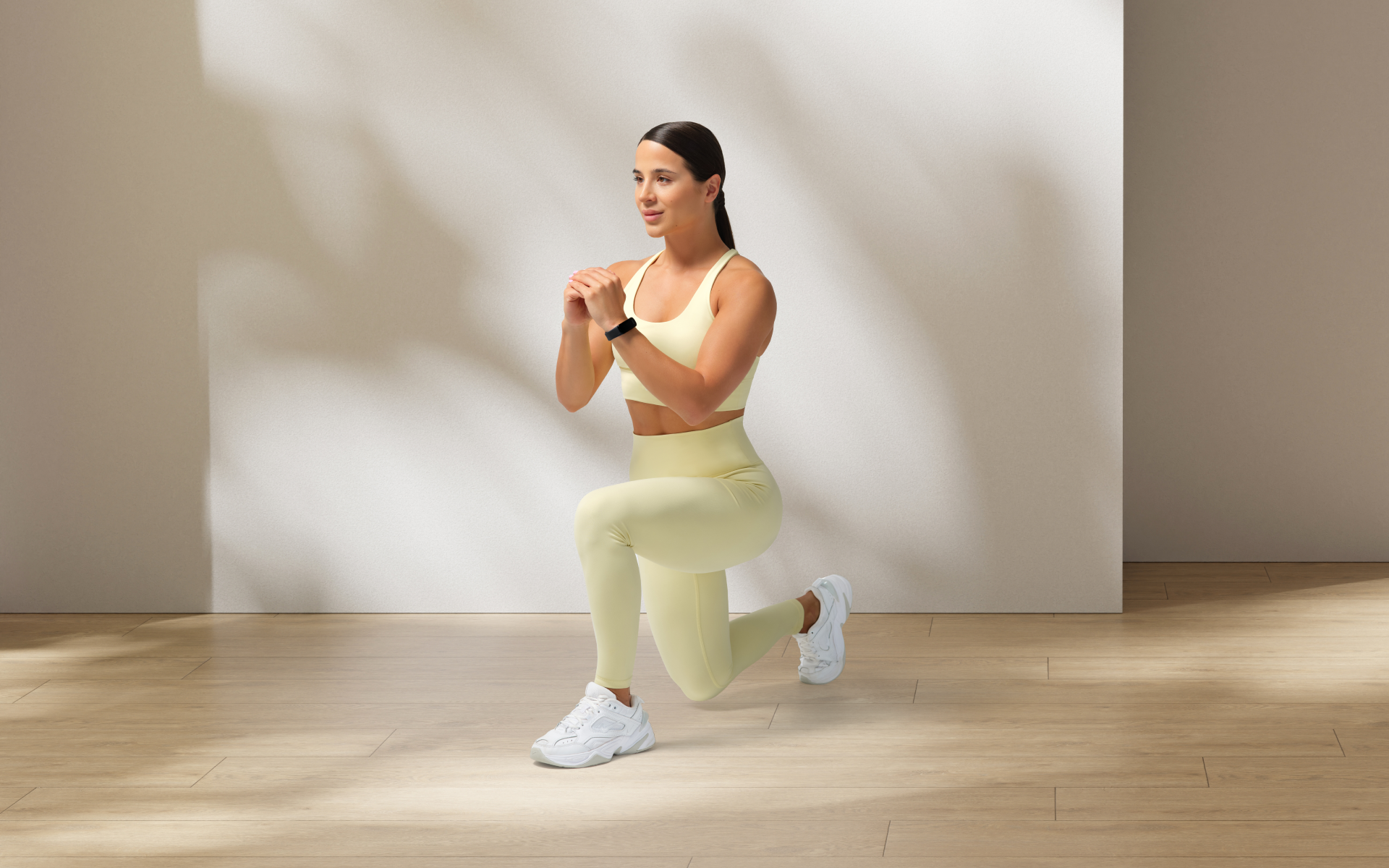If you’ve decided to have a healthy and fit lifestyle by regularly working out -congratulations! You’ve made a very positive decision for your health and wellbeing. Please note that even with the best intentions, it’s easy to fall into some common workout traps that can sabotage your progress and ruin your motivation. Beginners and advanced exercisers alike can fall victim to these problems, but with a bit of knowledge and some easy solutions you can overcome those troubles and continue towards your fitness goals. In this article, we’ll discuss 10 of the most common workout problems and how to fix them.
Get your personalized
meal plan!
Problem 1: You Don’t Have A Plan
Get up, head to the gym for an hour, and get on with your day. No goals, no structure, no plan. Sound familiar?
If you’re not carefully planning your workouts, you’re likely not getting the most out of them. Without a plan, it’s easy to become unfocused and end up wasting time at the gym with little to show for it.
The Solution
Create a workout plan that outlines your specific goals and the exercises you need to do to achieve them. This will help you stay focused and on track, ensuring that you’re getting the most out of your workouts.
If you’re finding it difficult to come up with a workout plan on your own, there are plenty of online resources and personal trainers who can help you get started.
It’s important that your plan takes into account your current fitness level and gradually builds up intensity as you become more comfortable with exercise.
Overdoing it too soon is a recipe for injury and burnout, so be sure to start slow and increase the intensity of your workouts gradually.
Read More: Should You Get A Massage Before Or After Your Workout?
Problem 2: You’re Not Progressing
You’ve been going to the gym for weeks (or even months) but you’re not seeing any results. You might be doing the same workout routine day in and day out, or maybe you’re just not working hard enough. Whatever the case, if you’re not progressing, your workouts will quickly become ineffective and boring.
There are several reasons why you’re not seeing the results you are hoping for:
Reason 1- You’re Not Challenging Yourself
If you’re doing the same workouts day after day, your body will quickly adapt and become more efficient at them. This is characteristic of the law of diminishing returns.
In order to continue seeing results from your workouts, you need to constantly challenge your body by increasing the intensity or duration of your workouts, or by adding new exercises.
Reason 2- You’re Not Eating Enough
If you’re not eating enough, your body won’t have the energy it needs to fuel your workouts and you’ll quickly become fatigued. In order to see results from your workouts, you need to make sure you’re getting enough protein, carbohydrates, and healthy fats.
Reason 3- You’re Not Getting Enough Sleep
If you’re not getting enough sleep, your body won’t have the energy it needs to fuel your workouts and you’ll quickly become fatigued. While you sleep, a hormone called human growth hormone (HGH) is released, which helps to repair and build muscle tissue (4).
The Solution
To see results from your workouts do these three things:
Focus On Progressive Overload
Progressive overload simply means gradually increasing the intensity or difficulty of your workouts over time. This can be done by adding more weight, reps, or sets to your exercises, or by doing more challenging variations of the exercises.
Why it works is due to how it continually challenges your body, forcing it to adapt and become stronger. If you don’t challenge your body, it will quickly adapt and you’ll stop seeing results from your workouts.
Figure Out What And How Much You Should Be Eating
To grow muscle, you need to be in a calorie surplus, which means you’re eating more calories than you’re burning. This is because muscle growth requires energy (in the form of calories).
To lose fat, you need to be in a calorie deficit, which means you’re eating fewer calories than you’re burning. This is because fat loss requires energy (in the form of calories).
To maintain your weight, you need to be eating the same number of calories that you’re burning. This is because your weight is determined by the energy balance between calories in and calories out.
You can use an online calorie calculator to determine how many calories you should be eating each day. Once you know how many calories you need to be eating, you can figure out how much of each macronutrient (protein, carbohydrates, and fat) you need to eat.
Protein is the most important macronutrient for muscle growth as it provides the building blocks for muscle tissue. Carbs are important for fueling your workouts and fat is important for hormone production (5).
You can use an online macronutrient calculator to determine how many grams of each macronutrient you need to eat each day.
Get Enough Sleep
Sleep is when your body recovers from your workouts and grows muscle. Most people need 7-9 hours of sleep per night. If you’re not getting enough sleep, you’re not going to see results from your workouts (4).
You can improve the quality of your sleep by establishing a regular sleep schedule, avoiding caffeine before bed, and sleeping in a dark and quiet room.
Looking for a way to break the vicious cycle of weight loss and tone up all the jiggly parts? Watch the extra pounds fly off and your muscles firm up with the BetterMe app!
Problem 3: You’re Struggling To Be Consistent
One of the most common workout mistakes people make is taking time off from the gym or not sticking to their workout routine. They struggle to show up for their workouts consistently and as a result, they don’t see the results they want.
There are several reasons why, no matter how hard you try, you can’t stick to your workout routine:
Reason 1: You’ve Set Unrealistic Goals
A big goal can be motivating at first, but it’s often difficult to maintain that level of motivation. When you meet your first challenge it’s easy to give up if you don’t have a strong enough reason to keep going.
Reason 2: You’re Not Enjoying Your Workouts
If you’re not enjoying your workouts, it’s going to be difficult to stick to them. You’re more likely to skip a workout if you don’t enjoy it more than if you do.
Reason 3: Your Workout Routine Doesn’t Fit Into Your Lifestyle
To make fitness a part of your lifestyle you need to find a way to make it work with your schedule and your life. If your workout routine is too time-consuming or inconvenient, you’re not going to stick to it.
The Solution
Set Realistic Goals
When setting goals, make sure they’re realistic and achievable. Break them down into smaller habits that you can accomplish on a weekly or monthly basis. This will make it easier to stay motivated and consistent with your workouts.
Find Workouts You Enjoy
If you don’t enjoy your workouts, try finding different exercises or workout routines that you do enjoy. There are many different types of workouts to choose from, so you’re sure to find something you enjoy.
Make Your Workouts Fit Into Your Lifestyle
If you want to make fitness a part of your lifestyle, find a way to make it work with your schedule and your life. This might mean working out at home, going to the gym during your lunch break, or getting up early to workout before work.
It’s important to find a routine that you can stick to so you don’t have to worry about skipping workouts.
Read More: Aerial Yoga Benefits: 10 Ways This Practice Will Elevate Your Workouts
Problem 4: Your Muscles Are Always Sore
Muscle soreness is a common issue, especially for beginners. It’s normal to feel some soreness after a workout, but if your muscles are always sore, it could be a sign that you’re doing too much too soon.
The science behind muscle growth explains some soreness. To grow muscles, you have to break them down first. When you work out, you’re breaking down muscle tissue. When you rest, your body repairs that tissue and makes it stronger (2).
The repair process is what causes soreness. The more muscle tissue you break down, the more soreness you’ll experience (2).
If you’re always sore, it could be a sign that you’re doing too much, too soon. It’s important to give your muscles time to recover.
Other causes of excessive muscle soreness include:
- Not stretching properly before and after your workouts
- Exercising the same muscles repeatedly without giving them time to recover
- Lifting weights that are too heavy for you
- Not hydrating properly
The Solution
Warm Up Before Your Workout
Warming up helps increase blood flow to your muscles and can help reduce soreness. A simple warm-up routine could include light cardio and some dynamic stretches (7).
Give Your Muscles Time To Recover
If you’re always sore, it might be a sign that you’re not giving your muscles enough time to recover between workouts. Try scaling back on the intensity. Make sure to give your muscles time to recover by not working out the same muscle group two days in a row.
You can also try using a foam roller or massage ball to help relieve muscle soreness.
Get Into Dynamic And Static Stretching
Dynamic stretching is a form of stretching that involves moving your body through a range of motion. It’s an active form of stretching that helps prepare your body for exercise.
Static stretching is a form of stretching where you hold a position for a period of time. It’s a passive form of stretching that should be done after your workout to help reduce muscle soreness.
Problem 5: You’re Always Tired
If you’re always tired, it could be a sign that you’re overtraining. Over training comes in different forms, including absence of rest days, excessively long sessions, and/or not allowing your body enough time to recover between workouts.
When you overtrain, your body produces too much cortisol. Cortisol is a stress hormone that can have negative effects on your body, including decreased muscle mass, increased body fat, and lowered immunity (1).
The Solution
Take A Rest Day
One of the best ways to prevent overtraining is to make sure you’re taking at least one rest day per week. This will give your body time to recover and can help reduce fatigue.
If you find that you’re still tired after a day of rest, it might be a sign that you need more than one day off. Try taking two consecutive days off each week.
Modify Your Workouts
If you’re not getting enough rest, it might be time to modify your workouts. Try shorter and more manageable workouts that don’t require as much energy. You could also try splitting up your workouts into two or three sessions throughout the day.
Reduce The Volume Of Your Workouts
If you’re doing too much, you might want to reduce the volume of your workouts. This means doing fewer sets and reps or using less weight.
If you tend to let yourself off the hook, raise the white flag when things get tougher than you expected, send yourself on an unconscious binge-eating trip – BetterMe app is here to help you leave all of these sabotaging habits in the past!
Problem 6: The Scale Won’t Budge
When it comes to fat loss and muscle gain, the scale is a double-edged sword. True, you want to lose weight to achieve a healthy body composition. However, the scale isn’t always the best way to gauge your progress.
If you’re working out hard and eating healthy, but the number on the scale isn’t budging, it could be a sign that you’re going through body recomposition.
What this means is that you’re losing fat and gaining muscle at the same time. When this happens, your body weight might stay the same, even though your body composition has changed for the better.
The Solution
Stop Weighing Yourself
If you’re fixated on the number on the scale, it might be time to take a break from weighing yourself. Weighing yourself can be misleading and can cause anxiety if the number on the scale doesn’t budge.
Get A Tape Measure
If you’re struggling to lose weight, you might want to start measuring your body composition instead. This can be done by using a tape measure to measure your waist, hips, and arms.
Take Progress Pictures
Another way to measure your progress is to take progress pictures. This is a great way to see how your body is changing, even if the number on the scale stays the same.
Problem 7: You Don’t Have Enough Energy For A Workout
It’s normal to have days when you don’t feel like working out. However, if you’re constantly struggling to find the energy for a workout, it could be a sign that you’re not getting enough calories.
When you don’t get enough calories, your body doesn’t have the fuel it needs to sustain a workout. This can lead to fatigue, lightheadedness, and low energy levels.
The Solution
Eat More Calories
If you’re struggling to find the energy for a workout, it might be time to increase your calorie intake. This will give your body the fuel it needs to sustain a workout and can help improve your energy levels.
Try Pre-Workout Supplements
If you’re having trouble getting energized for your workouts, try using a pre-workout supplement. These supplements are designed to give you an energy boost and can help you power through your workout.
Some common pre-workout supplement ingredients that give you an energy boost include (3):
- Caffeine – a stimulant that can help increase energy and focus.
- Creatine – a compound that helps improve energy production and can help you exercise for longer periods of time.
- Beta-alanine – a compound that helps reduce fatigue and increases muscle carnosine levels.
Problem 8: You’re Feeling Self-Conscious At The Gym
As a beginner, it’s normal to feel self-conscious at the gym. You might not know how to use the equipment or what exercises to do.
Even worse, you might worry that everyone is watching and judging you.
The Solution
Talk To Someone At The Gym
If you’re feeling self-conscious, one of the best things you can do is talk to someone at the gym. This could be a personal trainer, another member, or even the staff.
They can give you tips on how to use the equipment and can help you feel more comfortable at the gym.
Take A Group Fitness Class
Group fitness classes are a great way to get comfortable with working out in front of other people. In a group fitness class, everyone is there to workout and have fun.
You don’t have to worry about anyone watching or judging you. Plus, the instructors will help you with form and technique.
Problem 9: Your Skin Is Chafing
If you’re working out regularly, it’s normal for your skin to start chafing. This is a result of the friction between your skin and the clothes you’re wearing. It can also happen on the palms of your hands as you grip the bar or the handles of the machines.
Chaffing can be painful and can cause your skin to become raw and irritated (6).
The Solution
Choose The Right Clothing
One way to prevent skin chafing is to choose the right clothing. Make sure you’re wearing clothes that are made for working out. They should be breathable and fit snugly against your skin.
Avoid Wearing Tight Clothes
If you’re prone to skin chafing, avoid wearing tight clothes. Tight clothes cause more friction against your skin and can aggravate skin irritations.
Use A Lubricant
Another way to prevent skin chafing is to use a lubricant. There are a number of different lubricants that you can use, including body lotion, petroleum jelly, and sports cream.
Apply the lubricant to the areas that are prone to chafing before you work out. This will help reduce friction and will help keep your skin irritation-free.
Wear Gloves
If you’re having trouble with chafing on the palms of your hands, try wearing gloves. This will create a barrier between your skin and the equipment you’re using.
Exfoliate And Moisturize Your Hands
The palms of your hands are also prone to chafing. To help prevent this, exfoliate your hands regularly and moisturize them with a heavy cream. This will help keep your skin healthy and will reduce the chances of chafing.
Problem 10: Excessive Sweat Is Making You Uncomfortable
Sweat can make your clothes sticky and uncomfortable. This is especially true if you’re wearing synthetic fabrics, which tend to absorb sweat.
The Solution
Choose Natural Fibers
One way to avoid this problem is to choose clothes made from natural fibers. Cotton is a good choice, as it absorbs sweat and helps keep you cool.
Avoid Wearing Synthetic Fabrics
If you can, avoid wearing synthetic fabrics when you work out. These fabrics tend to trap sweat and can make you feel sticky and uncomfortable.
Wash Your Clothes After Each Workout
If you’re wearing the same clothes multiple times in a week, sweat and bacteria can build up. This can cause your clothes to smell and can make you feel uncomfortable.
To avoid this, wash your workout clothes after each use. This will help remove sweat and bacteria and will keep your clothes fresh.
Use A Deodorant Or Antiperspirant
If you’re still having trouble with sweat, try using a deodorant or antiperspirant. These products can help reduce sweat and will keep you smelling fresh.
The Bottom Line
Whether you’re a beginner or an advanced exerciser, you might run into some problems when you work out. But don’t let these problems stop you from reaching your fitness goals. With a little bit of effort, you can find solutions to these common problems and make your workouts more enjoyable.
DISCLAIMER:
This article is intended for general informational purposes only and does not serve to address individual circumstances. It is not a substitute for professional advice or help and should not be relied on for making any kind of decision-making. Any action taken as a direct or indirect result of the information in this article is entirely at your own risk and is your sole responsibility.
BetterMe, its content staff, and its medical advisors accept no responsibility for inaccuracies, errors, misstatements, inconsistencies, or omissions and specifically disclaim any liability, loss or risk, personal, professional or otherwise, which may be incurred as a consequence, directly or indirectly, of the use and/or application of any content.
You should always seek the advice of your physician or other qualified health provider with any questions you may have regarding a medical condition or your specific situation. Never disregard professional medical advice or delay seeking it because of BetterMe content. If you suspect or think you may have a medical emergency, call your doctor.
SOURCES:
- Central effects of stress hormones in health and disease: understanding the protective and damaging effects of stress and stress mediators (2008, nih.gov)
- Maximizing Muscle Hypertrophy: A Systematic Review of Advanced Resistance Training Techniques and Methods (2019, nih.gov)
- Multi-ingredient pre workout supplements, safety implications, and performance outcomes: A brief review (2018, biomedcentral.com)
- Physiology of growth hormone secretion during sleep (1996, nih.gov)
- Role of nutrition in performance enhancement and postexercise recovery (2015, nih.gov)
- Sports-related dermatoses among road runners in Southern Brazil (2014, nih.gov)
- Warm-up reduces delayed onset muscle soreness but cool-down does not: a randomised controlled trial (2007, pubmed.gov)

















